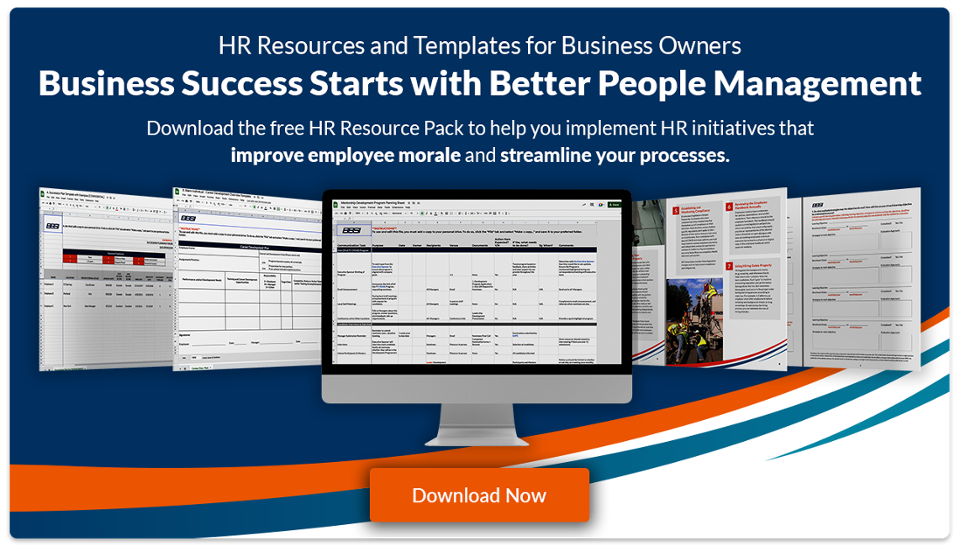Succession Planning for Small Businesses

Considering the amount of determination and hard work that goes into running your own business, it can be difficult to imagine passing along those responsibilities, or even the whole business, to someone else. Yet, this is a reality most business owners will eventually face. Having a plan in place to ensure that your business can transition to the next phase of its lifecycle is crucial to ensuring a seamless process when the day comes. Below you’ll find some best practices for successfully planning for your business’s future.
What is Succession Planning?
Succession planning is a long-term plan intended to outline the continuity of employee knowledge and responsibilities over time. This plan is a crucial asset for a company’s evolution and growth throughout its lifetime. By focusing on long-term business goals, succession planning can help you embrace the right mindset for the future. This form of planning is used to embrace existing talent and create a clear path forward for your company. Creating a dedicated plan that supports and encourages your staff will ensure you have the necessary leadership and specialized knowledge documented to continue throughout the lifecycle of your business.
Jump to the 9 Steps for Creating a Business Succession Plan >
What is a Succession Plan?
A succession plan is a spreadsheet or document that outlines all of the people in your organization, as well as positions that are currently available in the company or will become available as your company grows. The outlined positions must address not just the current state of your company, but also the future state over the next three to five years.
The plan should include any positions crucial for your company to grow and reach its goals, and which of your employees will fill those roles. It is common practice to list employees who have the potential to take over key roles and numerically define their potential for success in the role by percentage.
With this information, companies can identify talent gaps and recognize employee potential. When employee potential is clearly outlined, companies can take steps to guide employees toward future positions and keep an eye out for how their potential and preparedness will change throughout the years. The plan itself should include a snapshot of an employee based on the company's needs and their individual potential.
Download the Succession Planning Pack
How Do You Identify High and Low-Potential Employees?
Low-potential employees can be low-performing employees or, in some cases, high-performing employees who may not be interested in advancement. Though people commonly think that low-potential employees are a bad thing, however, that isn’t necessarily true as they often make up around 70% of your workforce.
High-potential employees are capable of growing into challenging positions. When you identify these individuals, you can look at skill gaps and identify areas of growth to ensure they can meet key needs at a later date. This is important for teaching soft skills and core competencies that can be utilized years from now.
Why Should Companies Have a Succession Plan?
Succession planning is important for all businesses, and especially for small or family-owned businesses because it empowers owners to look comprehensively at the future of their company. Often, a business owner's first instinct is to leave their business to their children. However, multi-generational succession planning tends to have a low success rate, with 40% surviving the transition to a second generation, 13% surviving to a third generation, and only 3% surviving to a fourth or beyond.
Having a succession plan in place ensures your business has dedicated employees who possess the passion and knowledge to continue operations, whether you sell your business or pass it on to your successor.
Helps Fill Key Management Positions or Replace Owners
Companies often focus on day-to-day operations instead of long-term planning. Some believe they can hold off on replacing key roles until the people in those positions leave, but often that isn’t realistic. Most businesses change and evolve over time. These changes can be in response to market dynamics, or common changes with your employees, like staff moving away or transitioning to other positions or industries. Being prepared for these inevitable changes can make necessary adjustments much easier.
Helps Owners Sell Their Business
When most entrepreneurs start their business, they don’t imagine selling them — but they should. Regardless of how you feel today, you should always keep your exit plan in mind. If you’d like to eventually sell your business for a premium price, you have to make it an attractive purchase for potential buyers.
Succession planning allows you to build a strong management team and strategic vision, giving you a higher chance of selling your business on the terms you want.
A good management team and refined processes will help you build a well-functioning operation that attracts prospective buyers and eases the transition to new ownership.
Benefits of Succession Planning
There are several key benefits of succession planning. Let’s explore some of the key ones.
Improves Employee Engagement and Retention with Targeted Career Development
Modern employees prioritize opportunities for growth, and companies that cannot offer career development will have trouble retaining top talent. Succession planning allows you to work with your employees to define their career paths and find opportunities for them as your business continues to grow. Family-owned businesses can offer their employees fulfilling careers with growth potential, but that often comes down to having a great plan in place.
Takes a Proactive Approach to Solving Future Challenges
No matter how hard you work, eventually, your business will face challenges. Personal or family problems, changes in the market, and unexpected staffing changes can all present unplanned bumps in the road. With a succession plan in place, you can be prepared to manage a change before it becomes a crisis. Waiting until the situation demands a response can lead to problems for your staff and has left many business owners stuck in less than ideal situations. Don’t wait for a health crisis, accident, or unexpected move to negatively impact your business.
Improves Company Culture by Creating a Learning Organization
Employees love companies that encourage growth and development, which is even more true among younger generations. Succession planning can create a culture in which leaders find ways to challenge their staff, recognize hard work, and track employee performance.
It is important to create an environment that encourages, trains and rewards good behavior to lead your company in a positive direction. This will nurture employees who are passionate about learning and career development.

Gives Leaders Greater Ability to Manage Lower Performing Employees
When an employee isn’t performing to the highest standards, it becomes difficult for management to respond or find the desire to do so. Ultimately, this leaves lower-performing employees carrying on with poor work and higher-performing employees carrying more of the workload.
A good succession plan can help managers find the power and desire to coach their employees and encourage them to improve. This means giving warnings or terminating an employee with multiple offenses, as well as providing clear benefits or incentives when someone performs well. With a good succession plan, you can hold managers accountable, encouraging them to be consistent with employees and continuously check on performance levels.
Helps Companies Promote Internally vs. Hiring Outside
External hiring is common, but it does come with its fair share of added expenses and training. When you promote internally or allow internal employees to step into prominent positions, you already know the person's capabilities. This means you can identify gaps and areas for improvement in advance and put plans in place to help the employee improve.
With an external hire, you can never truly guarantee what their performance will be after the interview process ends. There will always be a slight difference between the person you interviewed and the person who walks in the door on Monday. While external hires can be great, they introduce more variability.
Internal promotions can help your leaders tap into low and moderate-potential employees to build their talent, so they can take on bigger opportunities down the line. This provides your business with a secure pool of talent and shows employees your willingness to invest in their development.
Jump to the 9 Steps for Creating a Business Succession Plan >
Succession Planning Best Practices
The following best practices can help you create a succession plan to lead your company down a successful path, whether you are running it yourself or passing it along to someone else.
Start with Strategic Planning Before Succession Planning
Before creating a succession plan, you need a clear idea of where you want the company to go. This is where strategic planning comes in. Ask yourself where you want your company to be a year, two years, and five years from now. Consider new areas of expansion, areas that might be phased out, and what the future of your company and industry will look like. Look beyond the day-to-day survival strategy, and at your company's future potential instead.
Keep Legislation in Mind During Planning
Laws influence the way you do business whether you want them to or not, and these laws can change. You should plan for existing laws, but be ready to flex if new ones arise or existing ones change. If and when the time comes, you will need to know when the changes or new legislation will go into effect, so you can better plan for them. For example, Colorado has the Equal Pay for Equal Work Act requiring companies to post promotional opportunities internally. Planning ahead for legal requirements is important and will save you time and compliance headaches.
Don’t Label Employees “C” Players
In the nineties, companies began labeling low-performing employees as “C” players and removing them from their organizations. But this thought process can be extremely damaging to the culture and the psychology of an organization. Companies should refrain from labeling employees as “C” players and acknowledge how such labels influence how the organization will view and treat them.
Use Competency Mapping and Tools
Competencies are skills, experience, and anything else that can be used to elevate a business or improve workplace culture. Business owners and managers should utilize tools to count their employees' competencies and set up benchmarks to track their progress in areas of growth potential. With these tools, it becomes easier to understand which skills are needed for specific roles and how an employee can grow into them.
Conduct Regular Career Development Discussions and Measure Performance
A good performance management structure is crucial. This means using a method or system for regular feedback, paired with career development discussions. Helping employees identify and actively pursue goals is critical for the organization and individual, but only works when they have regular check-ins with feedback, even if it’s just a confirmation the person is progressing. Holding employees accountable and making development a priority can help them gain a sense of ownership and encourage them to take their own steps forward.
Utilize Mentorship
Mentorship is a powerful tool for teaching both soft and technical skills in a comfortable and supportive environment. Most importantly, mentorship is a powerful and emotional experience that allows people to exchange knowledge and build trust. The development that follows mentorship can have lasting, positive impacts that will grow company culture and push your business forward.

Keep Succession Planning Confidential
Succession planning involves a significant amount of sensitive information, which is why internal planning discussions must stay confidential. Scoring employee proficiency and identifying areas for improvement shouldn't be public information, as it could negatively impact their growth, opinion of the company, and culture overall.
Though much of the information will be shared with the individual and used to encourage growth, succession planning must be kept behind closed doors with the exception of the decision-makers involved. Employees should not feel like their areas for development are on display for their peers.
Communicate Career Development Plans to Employees
While you might not want to share every bit of succession planning with an employee all at once, it is important to involve them in the plan. If you identify a candidate for a future role, tell them, so you can gauge their interest. By sharing this information, you demonstrate to employees that they have a team supporting and sponsoring their growth. It also shows there is a clear path for progress, and you want them to succeed. In some instances, it might be appropriate to share this news with the rest of the staff as the employee’s responsibilities and focuses change.
9 Steps for Creating a Business Succession Plan
Creating your business succession plan can be accomplished with these nine steps.
1. Identify Significant Business Challenges and Goals for the Next 1-5 Years
Before you start succession planning, you need to discuss the future of the company with senior leaders and staff. You should address the overall company strategy and goals you have for the company’s future. This includes new products and services, as well as expansion opportunities or potential partnerships. Determine your company’s next steps, as well as your own, so you can plan accordingly. For example, if you plan on retiring or selling the business within the next few years, you have to start preparing now. Knowing where the business is headed will help you plan effectively.
2. Identify Critical Positions for Business Continuity and Success
After you identify where the business is going next, assess how employees fit into the plan. To determine how staff will play into the future of your company, begin looking at positions important for success and identify their future state. Do these positions exist already? Are they vacant? It is critical to identify what your company will need in order to fill them.
3. Identify Competencies, Skills, and Institutional Knowledge Critical to Success
After considering the company’s future and critical positions, map out which skills potential candidates need for these roles. Identifying future vacant positions and job requirements helps you prepare for the future your company deserves — one that is built on talented staff.
4. Consider High-Potential Employees and Determine Their Needed Competencies
Talent plays a key role in succession planning, so you must assess your staff and their future with the company. Recognizing employee potential and aligning that potential with the organization’s strategy for the future is important for growth and development.
A succession planning matrix should be used here and they come in three forms. The matrix can have three boxes, six boxes, or nine boxes. A simple three-box matrix can be enough, but owners who want to focus on a more intense level of detail will benefit from adding additional boxes for their convenience.
5. Create a Succession Planning Template
Once you have assessed the potential of your employees, the next step in the process is to add the employees to a Succession Planning Template. This template helps you identify which employees need to grow into future roles. Ask yourself what skills need to be developed to move your company and employees forward. This template should include critical positions, competencies, high-potential employees, action items, and a general commentary. You should record the information captured during the first four planning steps into a single and simple space you can refer back to in one quick glance.

6. Discuss Career Development with High-Potential Employees
In order for succession planning to help your company achieve its goals, employees need to know when they are being considered for important positions. Employees are more likely to lean in and pursue necessary growth when you make them aware of their potential future with the company. Sharing this information should occur before selecting employees for succession in case they are not interested in the role you’ve identified for them. It is important to know who is and isn’t willing to advance to ensure you don’t spend time and resources developing employees who don’t want to move into a certain role, even if they seem like an obvious fit.
7. Create Your Talent Pipeline
Your talent pipeline is the path you will use to fill key roles. After identifying your interested internal talent, you may still have vacant positions you’ll need to bring in external candidates to fill. Accounting for this upfront makes it much easier to track your progress toward filling critical positions. Continuously updating your document allows you to stay on track and gives you a snapshot of key employees and their developmental progress as they grow into their future positions.
8. Document Key Employees’ Institutional Knowledge Before They Leave the Organization
Employee knowledge is a precious resource organizations must make a concerted effort to document and preserve, especially with the increasing number of workers approaching retirement age. The knowledge and skills of experienced employees are critical for minimizing interruptions that come with the transitions.
9. Revisit Overall Succession Plan Quarterly and Annually
For a succession plan to be effective, companies must revisit the plan on a regular basis. Having scheduled discussions about recruiting new talent and promoting employees with potential, noting existing skills gaps, and removing termed employees will help keep your plan on track.
Succession plans should be consistently revisited and target employee performance should be discussed and responded to, whether that means creating new avenues for career development or addressing poor performance. Analyzing data over time will demonstrate how well your plan is working.
How BBSI Can Help with Succession Planning
At BBSI, we provide you with a dedicated team of professionals to help your company leaders facilitate the succession planning process to ensure your business sticks to its plans and makes progress toward its future goals. Our trusted partners will keep your information confidential and help you identify answers to the questions that keep you up at night.
As we work together, we will continuously revisit your plan to ensure your company stays on track and in compliance with federal and state legislation, while also offering advice for developing and managing talent. Contact your local branch today to see how BBSI can help you with your succession planning and talent development.
Disclaimer: The contents of this white-paper/blog have been prepared for educational and information purposes only. Reference to any specific product, service, or company does not constitute or imply its endorsement, recommendation, or favoring by BBSI. This white-paper/blog may include links to external websites which are owned and operated by third parties with no affiliation to BBSI. BBSI does not endorse the content or operators of any linked websites, and does not guarantee the accuracy of information on external websites, nor is it responsible for reliance on such information. The content of this white-paper/blog does not provide legal advice or legal opinions on any specific matters. Transmission of this information is not intended to create, and receipt does not constitute, a lawyer-client relationship between BBSI, the author(s), or the publishers and you. You should not act or refrain from acting on any legal matter based on the content without seeking professional counsel.

